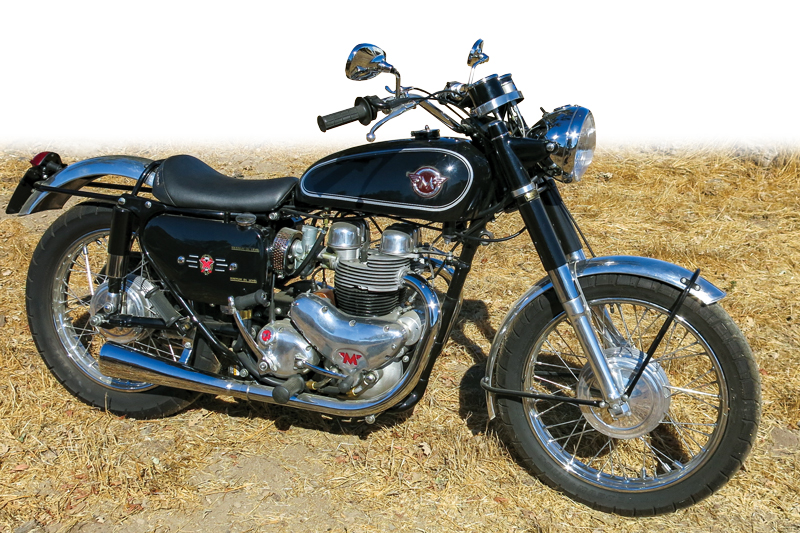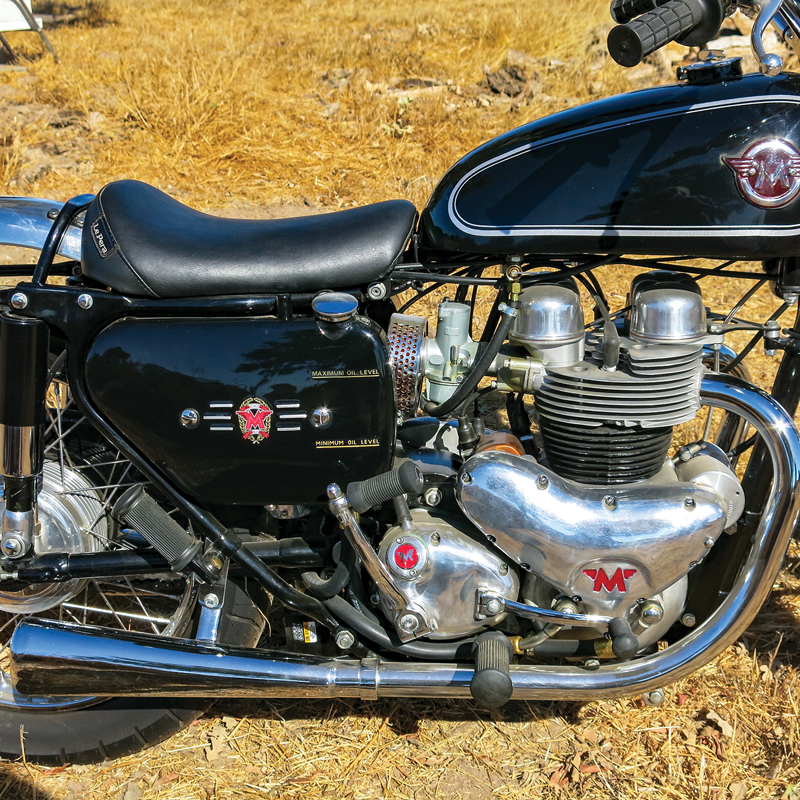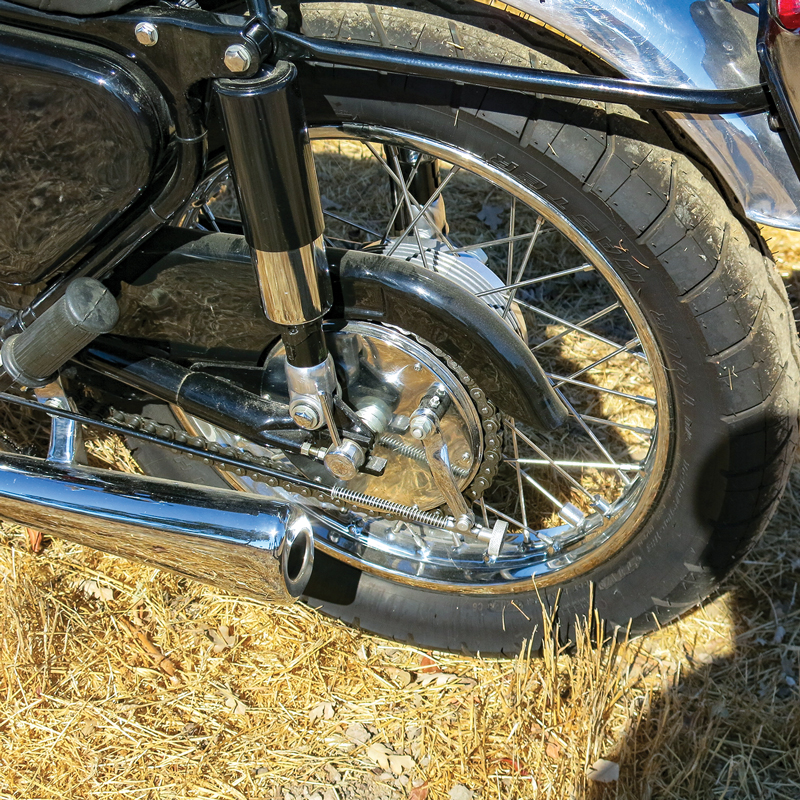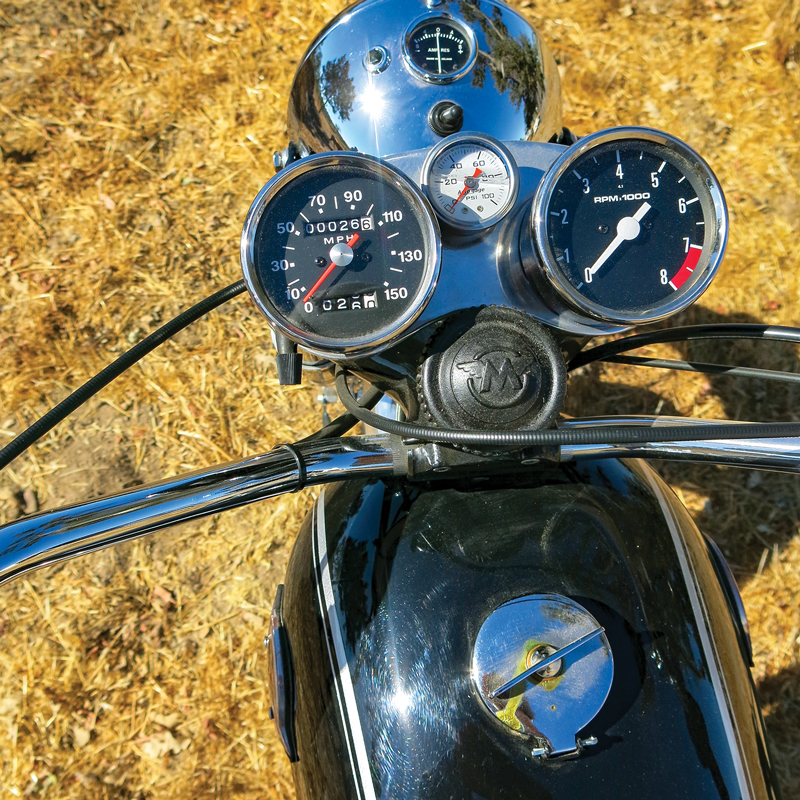
The 1950s and ’60s were the era of the UBM — Universal British Motorcycle — a parallel OHV twin sitting upright in the frame, in the 500cc to 750cc range. The original UBM was the Triumph 5T Speed Twin of 1938, soon to be copied by half a dozen of the major British motorcycle companies. Matchless, which built its first motorcycle at the Plumstead works in southeast London around 1901, came up with its own version in 1948, the 498cc G9, with a 66 x 72.8mm bore and stroke. And a fully sprung frame, with a swingarm rear suspension.
It should be noted that in the 1930s Matchless bought the AJS marque and the company became Associated Motor Cycles, Ltd., or AMC, the major difference between the two brands being the lettering on the gas tank.
The G9 engine differed from other UBMs in that it had a third bearing on the crankshaft, between the two connecting rods, to give added strength. The engine’s dry sump lubrication system used the camshaft to run two oil pumps, one on each side of the crank, aiding in efficient lubrication; apparently these engines could go 75,000 miles before any major work was needed. Quite remarkable for a UBM of the era, when top-end jobs were often done at 20,000 miles, bottom-end at 40,000.

The two cylinders were separate, as were the heads, and while this seemed to work well with the 500, as the engine grew larger the lack of rigidity appeared to enhance vibration. During the 1950s most factories increased the size of the engine, with 650cc being considered the maximum reasonable size for a UBM, due to those vibratory concerns. In 1955 Matchless elected to bore out the engine to 72mm for an increase to 593cc — called a 600, designated as a G11. This was followed by the G11CS, or Competition Sprung, a street-legal scrambler with easily removable lights, and the G11CSR, a more roadworthy version, often called the Coffee Shop Racer. The CS models came with higher compression ratios and other performance enhancements…and often more problems. The frame used a single downtube to meet up with the full cradle holding the engine.
In 1958 Matchless offered 17 different models, including the first G12 650. The very important American market had been demanding that 650, the dealers needing it to compete with the Triumph and BSA 650s. Small problem: the engine could not be bored out any more. Solution: increase the stroke to 79.3mm, or 646cc. That was the G12, with the basic road-going model having valanced fenders and a reliable 7.5:1 compression ratio, and two sportier CS models with an 8.5:1 compression ratio and light alloy fenders.

The restroked engine required a new crankshaft, made of “nodular” iron, which flexed enough to reduce vibrations. It was also designed to incorporate a Lucas alternator, though still with six-volt electrics. A new frame with twin downtubes now welded to the full cradle was developed, which did help in reducing the vibration inherent in a 650 vertical twin using a 360-degree crankshaft, although the single-tube frame was also used. The motorcycle seen here, which was built from bits and pieces, has a 1961 G12 engine in a 1959 single downtube frame. An AMC Teledraulic fork is up front, a pair of Girling shock absorbers at the back.
Gas tanks varied in size according to the model and year, but this ’61 G12CS carried only two gallons, all you would need in a race, and was said to weigh 425 pounds with a full tank. And with 5.3 pints of oil in the reservoir.
Other changes occurred over the G12’s years, including 12-volt electrics, sending out decent visibility from the seven-inch headlight. The basic G12 had 18-inch wheels, while this CS was running 19-inchers. Distance between the axles was a little more than 55 inches. Brakes were single-leading-shoe drums, an eight-incher on the front, seven on the back.

One interesting bit of history is that the Matchless marque was originally sold in the U.S. by Californian Frank Cooper, who became the AMC importer around 1946. He did quite well selling singles to win desert races, though the twins were not as popular.
In 1953, AMC acquired financially troubled Norton, although Norton production and sales remained quite separate, the U.S. importer being Joe Berliner, or J.B. Then, in 1960, AMC bought the Indian Sales Corp., which had been selling rebadged Royal Enfields — this was to get the Indian dealers, such as they were, to sell Matchboxes rather than Royal Oilfields. And AMC summarily fired Cooper, after 14 years of good work.
However, AMC filed for bankruptcy in 1962 (Cooper must have laughed), resulting in Matchless being merged more closely with Norton, and Berliner having to deal with Matchless as well. In early 1963, J.B. Matchless Corp. put a full-page ad in Cycle magazine promoting the G12CS and G12CSR…along with the 750cc G15 Matchless, which looked surprisingly like the Norton Atlas model that had appeared in 1962. In 1963 that old 1952 Matchless/Norton arrangement, keeping them separate, changed drastically as bill collectors were pounding on both doors, and Norton production moved from its old Birmingham factory 100 miles southeast to Plumstead.
Not surprisingly, interest in the G12 waned considerably. The last Matchless ad I could find in a U.S. moto-mag was in Cycle’s July 1966 issue, featuring the Atlas-based G15, and mentioning one G12CSR and two G80 singles. At the time British bureaucrats, knowing nothing about motorcycles, thought they could save the industry by merging Matchless, AJS and Norton into the company of an affluent entrepreneur and racecar driver, Dennis Poore. Poore was already looking after the Villiers engineering firm, which made most of the British two-stroke motorcycle engines. The Matchless and AJS names dropped from sight, and the new company was called Norton-Villiers.








Even though I enjoy riding my wonderful recent year BMWs I still miss my 1963 Matchless G12CS which I ordered from the factory to be delivered in France through the dealer in Paris. It arrived frustratingly late but when it finally got there it was a beautiful bike with a red tank and lots of chrome. It was a joy to ride while I lived in Paris and later when I toured many parts of western Europe circling down through Italy to Grease and later across the Mediterranean coast to Spain then back to the
Atlantic coast of France and finally to Paris once again. The bike was publicly received as the biggest and fastest non -racing bike on the streets. On many occasions, the police made it clear that they wanted to race from red light to red light. I never lost. The bike drew a crowd in cities and in mountain towns. I miss it dearly.
I had a 1964 G12 CSR while stationed in Londonderry, N. Ireland. Hannah (my future wife) and I put a lot of miles on that bike. I blew about half a dozen headlight bulbs on the bike because while it was a 12 volt system the second battery was hidden behind a “separator”. Since I only saw the one battery I assumed it was a 6 volt system. The dealer who sold it to me kept selling me 6 volt headlight bulbs because he did not know it was a 12 volt system either.
love to see pictures of yr bike. what did the police ride?
I had a 55 G9 but sold it in a weak moment. I now hv a G3L.
I still have a G12, 1962 reg but a 61model as it had magneto ignition. Great Bike!
HECK I OWNED A 1966 MATCHLESS G12CSR. IT HAD A LARGE CHROME GAS TANK AND MAGNETO..I DROVE IT ALL OVER CALIFORNIA AND EVEN UP INTO OREGON..GREAT FUN BIKE..I AM LOOKING FOR ONE NOW..THEY DID NOT MAKE MANY IN THEIR LAST YEAR OF MANUFACTURE…
hallo i want to purchage a matchless 350cc bike wheir i get this bike.
I have a 1958 AJS CS 31 would anyone out here know how many CS 31’s were produced.
I understand that they were primarily build for the US market. Someone has suggested that there were less tan 200 built.
My research shows 3 31 motors serial numbers ranging from 58 31 05917 to 58 31 07487
Any information would be greatly appreciated.